In-Depth Guide to Computer Motherboards and Their Roles
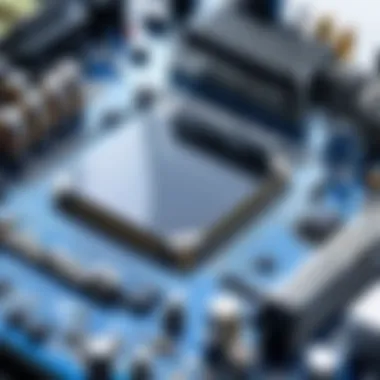
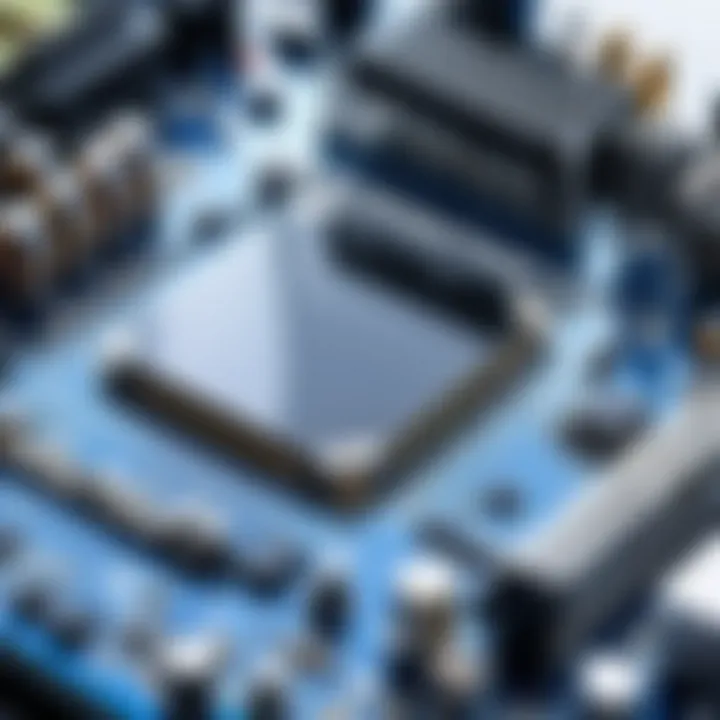
Overview of Topic
Prolusion to the main concept covered
Motherboards serve as the main circuit board in a computer, functioning as the backbone of the system. They facilitate communication between various components, including the CPU, RAM, storage devices, and graphics cards. Each motherboard is a unique combination of features, connections, and technologies, tailored to meet distinct user needs. Understanding this central architecture is crucial for anyone looking to build or upgrade their computer.
Scope and significance in the tech industry
In the ever-evolving tech industry, motherboards play a pivotal role. With advancements in processing power, memory technologies, and peripheral compatibility, the significance of choosing the right motherboard only increases. A well-designed motherboard can optimize system performance, reduce power consumption, and enhance the overall user experience. This is particularly important in specialized fields like gaming, data analysis, and software development.
Brief history and evolution
Going back to the roots of personal computing, early motherboards were comparatively simple, housing only the basic connectivity necessary for the CPU and memory. As technology advanced, motherboards evolved to accommodate a myriad of functionalities such as integrated graphics, networking capabilities, and even onboard sound. Today, motherboards cater to various niches, from casual computing to high-end gaming and professional workstations, signifying a critical shift in how these components are designed and implemented.
Fundamentals Explained
Core principles and theories related to the topic
At its core, a motherboard can be viewed as a complex crossroads, where signals converge and travel to their destinations. This ensures that all parts communicate effectively. Understanding this concept leads to a better appreciation of what differentiates one motherboard from another.
Key terminology and definitions
Several terms frequently arise when discussing motherboards:
- Form Factor: Refers to the size and layout of the motherboard, affecting compatibility with cases and other components. Common types include ATX, MicroATX, and Mini-ITX.
- Chipset: Dictates communication between the CPU and peripherals and can significantly impact compatibility and performance.
- Socket: The physical interface for the CPU to attach to the motherboard; different sockets can accommodate different processors.
Basic concepts and foundational knowledge
Before diving deeper into specific motherboards, one must understand key concepts such as power delivery systems, data lanes for different types of connections, and thermal management. Each of these areas affects both performance and longevity of the system.
Practical Applications and Examples
Real-world case studies and applications
Consider the scenario of a gaming enthusiast looking to build a high-performance rig. Choosing a motherboard with adequate PCIe slots for multiple GPUs and effective thermal design can lead to a significant performance boost. A practical example could be the ASUS ROG Strix X570-E, which offers a robust platform for any gaming setup.
Demonstrations and hands-on projects
Engaging in do-it-yourself projects is a valuable way to learn about motherboards. Building a basic computer requires an understanding of installing components like CPUs, RAM, and storage on the motherboard, offering practical insights into how they interconnect and operate.
Advanced Topics and Latest Trends
Cutting-edge developments in the field
Recent trends highlight the shift towards modular designs, enabling users to easily upgrade components without replacing the motherboard. Technologies like Thunderbolt 4 and PCIe 4.0 provide greater bandwidth and support for faster data transfer rates, making them critical for high-performance needs.
Advanced techniques and methodologies
Potential users should familiarize themselves with practices like overclocking, which can significantly increase the performance of CPUs and memory. Some motherboards come with built-in features for monitoring voltage and temperature, making them ideal for such capabilities.
Future prospects and upcoming trends
As artificial intelligence and machine learning applications grow, motherboards are likely to adapt to accommodate new technologies. Expect to see enhanced AI-powered workloads and more efficient processing units, which can further impact overall system design.
Tips and Resources for Further Learning
Recommended books, courses, and online resources
- "Upgrading and Repairing PCs" by Scott Mueller: Ideal for beginners wanting a deeper understanding of PC hardware.
- Coursera and edX: Platforms offering courses on computer hardware and architecture.
Tools and software for practical usage
Using tools like CPU-Z and HWMonitor helps in understanding system components, identifying specifications, and monitoring health status. Furthermore, forums on platforms like Reddit and tech communities can provide unique insights and problem-solving experiences.
"A motherboard is like the conductor of an orchestra, harmonizing all components to create a seamless performance. Understand it, and you hold the key to a powerful system."
With a given appreciation for how motherboards function and evolve, readers are better equipped to make informed decisions when diving into the vast world of computer technology.
Preamble to the Motherboard
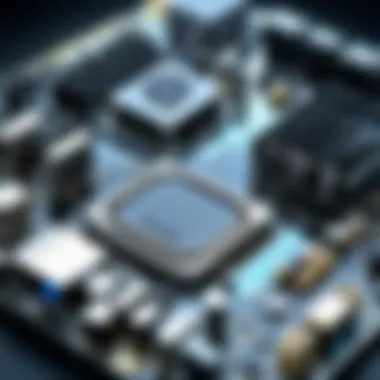
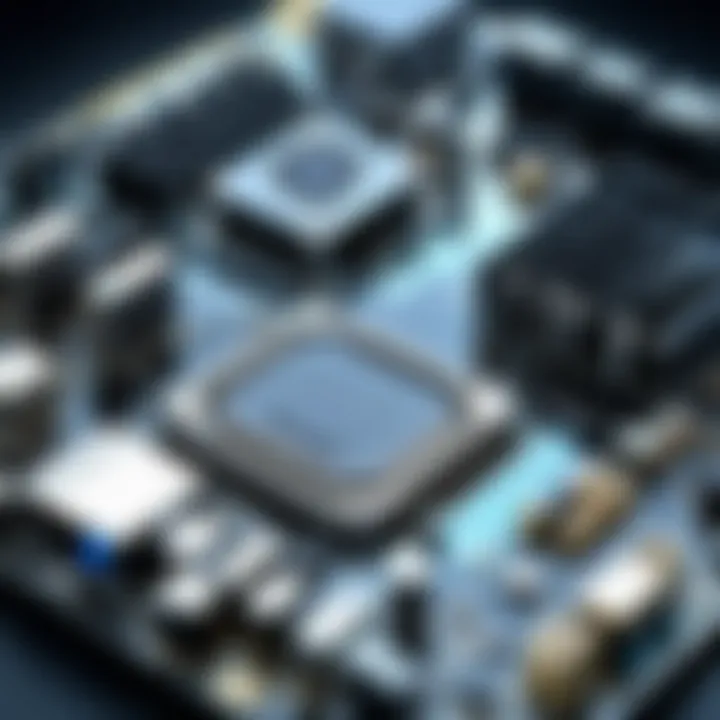
Understanding motherboards is akin to deciphering the core of a computer system. These integral components serve as the backbone, linking all hardware together and facilitating communication between them. Without a well-functioning motherboard, even the fastest CPU will struggle to perform, and premium RAM will be rendered ineffective. The motherboard's architecture directly affects how various components interact, which can enhance or limit overall performance. Thus, diving into its definition and historical significance unfolds a clearer picture of its crucial role in both everyday computing and high-performance systems.
Definition and Purpose
A motherboard, often referred to as a mainboard or system board, is the central printed circuit board (PCB) in a computer. It houses the CPU, memory slots, storage connectors, expansion slots, power connectors, and, often, integrated graphics. Essentially, it acts as the heart and nerve center of the machine, allowing different components to communicate. When you think about a computer, you might picture the processor whirring away, but it's the motherboard that orchestrates the entire operation. Its primary purposes include:
- Connection: It merges all the essential components—CPU, RAM, storage, and peripherals—into a cohesive unit.
- Power Distribution: It channels electricity from the power supply to various parts of the system, ensuring everything runs smoothly.
- Data Transfer: By using physical pathways called buses, it allows data to flow between components swiftly, influencing overall performance.
Without a proper understanding of a motherboard's role, one might underestimate how vital it is for effective computing. The type, design, and capabilities of the motherboard can dictate how the system performs activities, from basic browsing to intense gaming or professional workloads.
Historical Perspective
The journey of motherboards traces back to the early days of computing. Initially, computers were rudimentary; they did not feature motherboards as we know them today. Instead, individual components were wired directly to each other, making maintenance and upgrades complex. As technology evolved throughout the 1980s, the introduction of the IBM PC in 1981 signaled a dramatic shift. It utilized the motherboard concept, which integrated various components and standardized connections.
This innovation simplified the consumer experience and set the stage for modular computing, where users could upgrade or replace parts without complete overhauls. Over subsequent decades, numerous iterations and improvements emerged. For example, the release of the ATX form factor in the 1990s revolutionized design by introducing layout standards that improved heat management and installation efficiency. It ensured multiple slots for expansion cards, effectively shifting how computers could be customized.
Furthermore, as technology progressed, the variety of motherboards grew—from the compact Mini-ITX to the larger E-ATX boards. Each type caters to specific use cases, reflecting the diverse computing needs that surfaced over the years.
In summary, a motherboard embodies the evolution of computer technology, adapted to meet the demands of an increasingly complex digital world. Its definition and historical development highlight not just its function, but its profound impact on the user experience and technical possibilities.
Core Components of a Motherboard
The motherboard is akin to the spine of a computer system, linking various elements together and ensuring smooth communication. Understanding the core components is essential, as these parts dictate the overall functionality and performance of the entire unit. Each component fulfills a specific role, and when combined, they create a seamless interplay that directly influences the computer’s efficiency in executing tasks—from gaming to professional-grade video editing.
CPU Socket
The CPU socket is fundamentally the birthplace for the central processing unit. This component is critical because it determines which processors can be installed on the motherboard. Different sockets are designed for various CPU families, influencing not only performance but also upgrade options. For instance, the Intel LGA 1200 socket is tailored for specific 10th and 11th generation Intel processors, whereas AMD's AM4 is a versatile socket supporting numerous Ryzen chips.
- Types of CPU Sockets: The most common types include LGA (Land Grid Array) and PGA (Pin Grid Array). The choice of socket affects the power delivery design and can impose restrictions on cooling solutions, further demonstrating its significance in system design.
- Upgrade Considerations: When planning to upgrade your CPU in the future, it’s crucial to select a motherboard with a compatible socket type. Opting for a newer socket can provide more room for future advancements, ensuring your investment is sound.
Chipset
The chipset acts as the traffic manager for data flowing between the CPU, memory, storage, and other peripherals. It dictates the compatibility of the motherboard with various components and has a substantial impact on performance, especially with multiple devices connected.
- Functionality: Each chipset offers a distinct set of features and capabilities; for example, Intel chipsets support overclocking on select models, while others prioritize stability over raw speed.
- Compatibility with Features: The chipset also defines key functionalities such as how many USB devices can be interconnected, the maximum RAM speed, and the support for features like RAID configurations. A solid understanding of the chipset can significantly aid in selecting the right motherboard based on performance needs.
Memory Slots
Memory slots are crucial for determining how much RAM you can install and what type of RAM is compatible. Typically designed as DIMM slots for desktops, these connectors allow the memory modules to interact with the CPU and chipset.
- DDR Generations: The type of RAM, be it DDR4 or DDR5, is strictly linked to the motherboard. Utilizing newer generations can enhance performance, making a careful review of memory slots essential for gamers and professionals seeking high efficiency.
- Dual-Channel vs. Single-Channel: Most motherboards support dual-channel configurations, allowing data to be accessed more efficiently when paired correctly, which can boost overall performance.
Expansion Slots
Expansion slots provide the pathways for adding additional cards like GPUs, sound cards, or network cards. They are an essential feature for users who need more from their system beyond the built-in capabilities.
- PCIe Slots: The most common type of expansion slots are PCI Express slots. The revision and number of lanes available significantly dictate potential performance. For instance, PCIe 4.0 slots can offer double the bandwidth of PCIe 3.0, which is crucial for high-performance graphics cards.
- Considerations for Future Upgrades: Users anticipating upgrades or new installations should examine the available slots. A motherboard with ample PCIe slots allows room for future enhancements, thus prolonging the useful life of the system.
Power Connectors
Every motherboard houses power connectors to distribute electricity from the power supply unit to various components. The main connector type for powering the motherboard is the 24-pin ATX connector, alongside additional connectors dedicated to the CPU and graphics cards.
- Importance of Quality Components: Choosing a power supply with reliable connectors ensures greater stability in data processing and can help prevent unexpected shutdowns or hardware failures.
- Varying Power Needs: Depending on the number of installed components, the power supply’s wattage must be considered, especially for high-performance builds where multiple GPUs may be used.
Storage Connectors
Storage connectors are crucial for data access and storage management, with SATA and M.2 connectors being the most prevalent. These connectors allow for a range of storage devices, from traditional HDDs to the faster NVMe SSDs.
- Types of Storage: SATA connectors support standard SSDs and HDDs, whereas M.2 connectors allow NVMe SSDs to connect directly to the motherboard, significantly improving load times and system responsiveness.
- Configurations: Users should think about current and future storage needs when selecting motherboards. The number of available connectors can dictate how many storage devices can be utilized, impacting overall system performance and flexibility.
Investing time in understanding these core components will pay off in significant ways, particularly in achieving the desired performance benchmarks for your specific needs. A well-chosen motherboard harmonizes all these elements, paving the way for a more efficient computing experience.
Types of Motherboards
Understanding the different types of motherboards is crucial. They form the backbone of any computer system, influencing everything from size to functionality. It’s not just about hooking up the processor; it’s about ensuring the right combination of components work seamlessly together. Here we’ll explore several common types: ATX, Micro-ATX, Mini-ITX, and a few others that cater to specialized needs. Each form factor comes with its own set of benefits and limitations, guiding users on what best suits their specific goals.
ATX Motherboards
ATX motherboards are akin to the big kahunas of the motherboard world. Measuring 305 mm x 244 mm, they provide ample space for a plethora of components. The advantages? Well, they offer more expansion slots, aiding users who wish to add graphics cards, sound cards, or any other peripherals later on. Additionally, ATX boards typically support a wider range of RAM configurations.

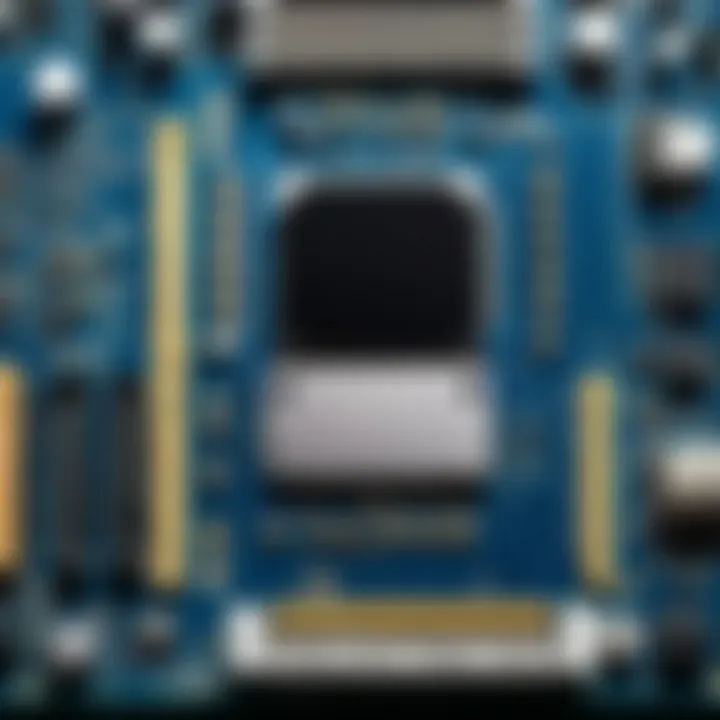
For gamers and content creators, this form factor can be a game-changer as it allows for powerful CPUs and advanced cooling solutions. The layout is designed to minimize bottlenecks, ensuring that data can flow smoothly across the different hardware. However, one thing to keep in mind is that they require a larger chassis. If you’re tight on space, this might not be your best bet.
Micro-ATX Motherboards
Micro-ATX boards are a sweet spot between size and capability. They come in at 244 mm x 244 mm, meaning you get a motherboard that can fit into smaller cases without scrimping on performance. These boards generally include a sufficient number of expansion slots for most casual gamers or office setups, typically supporting 4 DIMM slots for RAM.
The compact size makes them a favorite for budget builds, where saving space is key. You can find many offers that pack a lot into a small footprint without breaking the bank. However, there’s a trade-off: fewer expansion slots and sometimes lesser support for multi-GPU configurations compared to their bigger cousins.
Mini-ITX Motherboards
Mini-ITX boards are the pint-sized powerhouses in the motherboard range, measuring just 170 mm x 170 mm. They’ve gained popularity among those who prioritize compact setups, like home theater PCs or ultra-small form factor (USFF) builds. You’d think that with such size, there’s no room to spare for components, but that’s where creativity takes the helm.
These motherboards typically come with only one PCI Express slot and two DIMM slots, significantly limiting expandability. Yet, their compactness might just be a boon for small spaces. Plus, they’re great for energy-efficient builds, fitting nicely into power-saving goals. If your computing needs are basic or you're particularly space-conscious, Mini-ITX can dramatically simplify your life.
Other Form Factors
The world of motherboards isn’t limited to ATX, Micro-ATX, and Mini-ITX. For specialized applications, you might run across several other types, such as:
- E-ATX Motherboards: These are extended ATX boards, great for workstation use where additional hardware needs to fit in. They provide more room for advanced cooling solutions as well.
- Nano-ITX and Pico-ITX: These variants cater to embedded systems and ultra-compact builds. Their small size often means that they run in niche markets.
- Flexible Motherboards: Some modern solutions integrate features that allow for modular components, optimizing for specific user scenarios.
Choosing the right motherboard type is not just about personal taste; it’s about aligning the motherboard’s features with your needs. The decisions you make can affect performance, power consumption, and future upgrade potential.
"Getting the right motherboard is like laying the foundation for a house. If it’s shaky, everything built on top will suffer."
Whether it’s choosing an expansive ATX for a gaming rig or a compact Mini-ITX for a space-saving PC, it's about making an informed decision that suits your individual demands.
Motherboard Compatibility
Motherboard compatibility is a crucial factor when it comes to building or upgrading a computer system. It’s not just about slapping together different parts and hoping for the best. When all is said and done, compatibility ensures that various components work harmoniously, maximizing performance while minimizing frustrations. Lack of compatibility can lead to unnecessary hurdles and could even render your system inoperable. In the following sections, we will explore the key aspects of compatibility: CPU, RAM, GPU, and Power Supply.
CPU Compatibility
The CPU (Central Processing Unit) is essentially the brain of your computer. When considering compatibility, it's essential to ensure that your chosen processor fits snugly into the CPU socket of your motherboard. Each motherboard is designed to support specific CPU families and architectures. For instance, an AMD Ryzen processor won’t play well with an Intel motherboard.
Moreover, the chipset on the motherboard plays a vital role in determining which CPUs are supported. Make sure to cross-check the motherboard documentation or the manufacturer's website for a comprehensive list of supported CPUs. When selecting your components, always keep in mind the following:
- Socket Type: Ensure the socket for the CPU matches what's on the motherboard.
- Chipset Compatibility: Not all CPUs work with every chipset, even if the socket fits.
- BIOS Updates: Sometimes, newer CPUs may require a BIOS update before they can function correctly on older motherboards.
"The right match between CPU and motherboard elevates your computing experience, while the wrong one may lead to nightmares of incompatibility."
RAM Compatibility
RAM (Random Access Memory) compatibility also holds significant weight in ensuring each component can communicate smoothly. Each motherboard has specific memory slots which support various RAM types and speeds. Here are some essential factors to note:
- Memory Type: Modern motherboards typically support DDR4, whereas older ones might only work with DDR3 or even DDR2.
- Capacity Limitations: Motherboards generally have a maximum amount of RAM they can handle. You wouldn't want to invest in a hefty amount of RAM only to find out that your motherboard can handle less than half of it.
- Speed and Timings: Different RAM modules have different speeds and timings. While backward compatibility usually exists, it's always wise to match the speed of your RAM to avoid bottlenecks.
GPU Compatibility
When it comes to graphics processing units, or GPUs, the main consideration is ensuring that your graphics card fits physically in the expansion slot and is supported by the motherboard's chipset. Common GPUs use PCIe x16 slots, so verifying that your motherboard has this interface is a must. Here are some points to consider:
- Form Factor: Ensure that the GPU's size does not obstruct other components. Some high-end graphics cards tend to be quite lengthy.
- Power Requirements: Some GPUs need additional power connections from the power supply, so ensure you have the necessary connectors available.
- Compatibility with Integrated Graphics: If you're planning to use a dedicated GPU, check that the integrated graphics options of your motherboard don’t interfere with it.
Power Supply Compatibility
The power supply unit (PSU) feeds each component with the necessary power to function, so its compatibility with the motherboard is paramount. Key aspects include:
- Connector Types: Modular power supplies often come with various connectors. Ensure you have the right ones, especially for the CPU and motherboard main power connection.
- Wattage: Check that your power supply provides enough wattage not just for the motherboard, but for other components as well. Underpowered systems can lead to instability.
- Efficiency Ratings: Consider looking for power supplies with good efficiency ratings. This isn't directly about compatibility but can impact overall system performance and electricity bills in the long run.
In summary, understanding motherboard compatibility isn’t just about fitting parts together; it’s a careful consideration of various elements that interconnect to create a coherent, effective system. Ensuring compatibility can lead to a smoother setup and a more efficient machine.
Impact of Motherboards on Performance
The motherboard is often overlooked in the grand scheme of a computer's performance, but its role is undeniably pivotal. It acts as the central hub where all components communicate, influencing everything from speed to efficiency. Understanding how motherboards impact performance can help users optimize their systems, whether for gaming, professional work, or general use.
Overclocking Potential
One of the key factors that sets motherboards apart is their overclocking potential. For enthusiasts who demand extra performance, overclocking allows the CPU and RAM to run faster than their base speeds. Not all motherboards are created equal in this aspect; the higher-tiered models often include advanced cooling features and BIOS settings tailored for overclocking.
When you're choosing a motherboard for overclocking, consider these aspects:
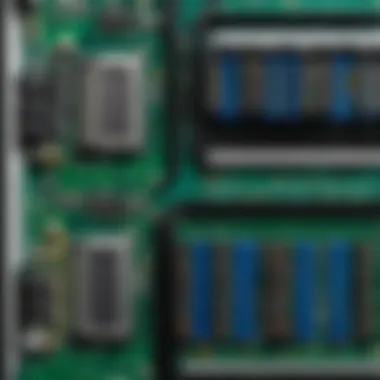

- Power Phases: More power phases mean it can provide more stable power to the CPU, essential for sustained overclocking.
- Cooling Solutions: Effective heat dissipation is critical, as overclocking generates additional heat.
- BIOS Features: A user-friendly BIOS that allows fine-tuning of settings can make or break an overclocking experience.
To illustrate, if you pick a motherboard like the ASUS ROG Strix series, you’ll find extensive options for tweaking. This allows users to push their CPU, such as an AMD Ryzen, to achieve higher clock speeds while maintaining stability.
System Stability
On the other side of the coin is system stability. A high-performance setup may demand more than just raw power; it requires a motherboard that can handle the stress of multiple components under load. Stability ensures that the computer runs smoothly without crashes or data loss, especially during intensive tasks like gaming or video rendering.
Motherboards with quality capacitors and robust construction tend to provide better system stability. Key considerations include:
- RAM Compatibility: Ensure the motherboard can support the amount and speed of RAM you plan to use.
- Overall Build Quality: Look for motherboards with names known for durability, like Gigabyte and MSI, particularly in the gaming or workstation arena where system stability is paramount.
- Driver and Firmware Updates: Regular updates can fix bugs that might compromise system stability.
"Investing in a reliable motherboard saves you headaches down the line, ensuring your system runs smoothly while maximizing its performance potential."
A motherboard like the MSI MPG X570 Gaming Plus, for instance, showcases a balance of both overclocking capability and stability, making it a favorite among users who demand high reliability coupled with performance.
Future Trends in Motherboard Technology
Motherboards are the backbone of computer systems, and their role evolves as technology progresses. It's crucial to understand emerging trends that can shape future designs and functionalities. As we venture further into a world dominated by faster, more efficient computing, the trends in motherboard technology become pivotal. These innovations can markedly improve performance, decrease energy consumption, and enhance usability. They also address user needs more effectively as new technologies emerge in various sectors, from gaming to artificial intelligence.
Emerging Technologies
A few noteworthy emerging technologies have the potential to revolutionize motherboard design:
- PCI Express 5.0 and Beyond: This newer version of PCIe allows for higher data transfer speeds—up to 32 GT/s per lane. The implications for storage and GPUs are immense. Users will notice faster load times and more seamless gameplay experiences. Furthermore, as devices increasingly rely on high-bandwidth data transfer, this technology will only grow in relevance.
- DDR5 Memory Support: The shift from DDR4 to DDR5 RAM is already creating waves. DDR5 offers higher bandwidth and increased capacity, which is essential for tasks such as rendering high-resolution graphics and running multiple applications simultaneously. Motherboards capable of harnessing DDR5 memory will thus provide a distinct performance edge.
- Integrated I/O Technologies: Features such as integrated Thunderbolt ports and Wi-Fi 6 are becoming standard on advanced motherboards. These technologies make connectivity simpler and faster, catering especially to professionals and gamers who require rapid data exchange and minimal latency during their activities.
- Smart Cooling Solutions: Cooling remains an essential aspect of system stability and durability. Innovations like AI-based cooling systems and more efficient heat sinks are appearing. Such solutions will ensure that components maintain optimal temperatures, extending their lifespan and allowing for higher performance levels.
"The motherboard acts as the center of a computer system, and its evolution reflects the demands and capabilities of modern technology. Invested in its development is an investment in the future of computing itself."
Sustainability Considerations
With an increasing awareness of environmental impacts, sustainability has become a pressing focus in motherboard design. Concerns extend beyond the materials used; they also encompass energy efficiency and longevity. Here’s a closer look:
- Eco-friendly Materials: There is a growing trend toward utilizing sustainable materials in motherboard production. Manufacturers are exploring recyclable plastics and eco-friendly soldering methods that reduce environmental footprint. This not only meets regulatory requirements but also appeals to environmentally-conscious consumers.
- Energy-efficient Designs: As energy costs rise and environmental regulations tighten, energy efficiency in motherboard design is more important than ever. Boards that can operate effectively with lower voltages and have power-saving features will undoubtedly see higher demand. These designs ensure that systems run cool and consume minimal energy, ultimately saving on operational costs.
- Modular and Upgradeable Designs: Sustainability also involves extending the lifespan of technology. Modular motherboards that allow users to upgrade specific components instead of replacing the entire board cater to this need. This approach not only saves consumers money but also reduces electronic waste, promoting a more sustainable tech ecosystem.
Best Practices for Selecting and Upgrading Motherboards
When it comes to computer-building, the motherboard can make or break your system's performance and compatibility. This section shines a light on the critical practices you should adopt when selecting and upgrading motherboards. Choosing the right motherboard ensures not just seamless integration with components but also optimal performance for your desired applications.
Assessing Your Needs
Before you dive into the vast sea of available motherboards, take a step back and evaluate what you actually need. This means understanding how you’ll use your computer. Are you aiming for high-end gaming? Or perhaps you’re constructing a workstation for programming or data analysis? Each use case has specific requirements.
- Gaming: Look for a motherboard with multiple PCIe slots for GPUs and ample RAM slots. Also, don’t forget to check for advanced cooling options, especially if you're planning to overclock.
- Professional Work: Consider motherboards that support such features as ECC memory support, which enhances reliability in critical tasks.
- General Use: For basic needs like web browsing and office applications, a more budget-friendly option suffices. Look for a reliable chipset that supports your CPU type without bells and whistles that are unnecessary.
Once you assess your use case, narrow down the options based on specifications. It’s vital to ensure your chosen board supports your preferred CPU, RAM type, and any other peripherals you may opt for.
Budget Considerations
$$ You get what you pay for, so don’t scrimp on a motherboard just to save a few dollars.$$
This is often where passionate builders find themselves facing a reality check. A motherboard acts as the foundation of your computer; investing a bit more can save you headaches later on. Here are a few aspects to consider:
- Price Range: Motherboards can range from around $50 to several hundred dollars. It's crucial to determine what's within your budget while holding out for the features critical to your needs.
- Future-proofing: Investing a little extra can provide adaptability. Features such as more RAM slots and additional PCIe slots can save you from future upgrades needing a complete overhaul.
- Brand Reliability: While brand loyalty can sometimes feel like a minefield, researching reputable brands like ASUS, MSI, or Gigabyte can ensure longevity and good customer support. If something goes awry, you want a team that stands behind its products.
Finale
In summary, the conclusion of this article serves as a vital checkpoint for understanding the multifaceted role of motherboards in the landscape of computer systems. It underscores how these intricate components are pivotal not just for the functionality but also for the longevity and adaptability of your computer setup.
One key element to reflect on is the relationship between motherboard types and specific user needs. From gamers seeking advanced cooling systems to creators in need of high-speed data access, understanding this connection can significantly guide purchasing decisions. Moreover, it’s essential to evaluate the compatibility factors discussed earlier, ensuring that each component harmonizes for optimal performance.
Several benefits emerge from this knowledge:
- Enhanced Performance: Choosing the right motherboard can alter system response times, data processing capabilities, and overall computing efficiency.
- Future-Proofing: With technology moving at a breakneck speed, investing in a flexible and robust motherboard can save one from frequent upgrades, making a long-term investment more viable.
- Customization Potential: A well-chosen motherboard opens doors for expandability—be it adding RAM, an upgraded GPU, or advanced cooling systems.
When considering the complexities of motherboard selection, the interplay of features such as power delivery and thermal management rises to prominence. These considerations aren't just technical specifications; they are crucial to ensuring stability during intensive operations.
"The motherboard is the backbone of your computer; it connects all components, ensuring they work together seamlessly."
In closing, knowledge of motherboard architecture, compatibility, and performance impact equips users with the tools needed to navigate today’s digital challenges. Thus, arming oneself with these insights can lead to informed choices, transforming a basic setup into a tailored powerhouse capable of meeting individual requirements.
Recap of Key Points
To wrap up, let's briefly recap some important aspects highlighted in this comprehensive overview:
- Definition and Function - The motherboard is fundamentally the core of the computer, housing and connecting all critical components.
- Types of Motherboards - Various form factors such as ATX, Micro-ATX, and Mini-ITX serve different user needs.
- Compatibility Factors - Compatibility between CPU, RAM, and GPU is essential for system stability and performance.
- Performance Influence - A motherboard affects everything from processing speed to the ability to overclock.
- Future Trends - Embracing emerging technologies and sustainability considerations is crucial as we move forward.
- Selecting Best Practices - Assessing needs and budget will lead to a more satisfying setup.
Keeping these points in mind will allow users to navigate the intricate field of computer motherboards more proficiently.







